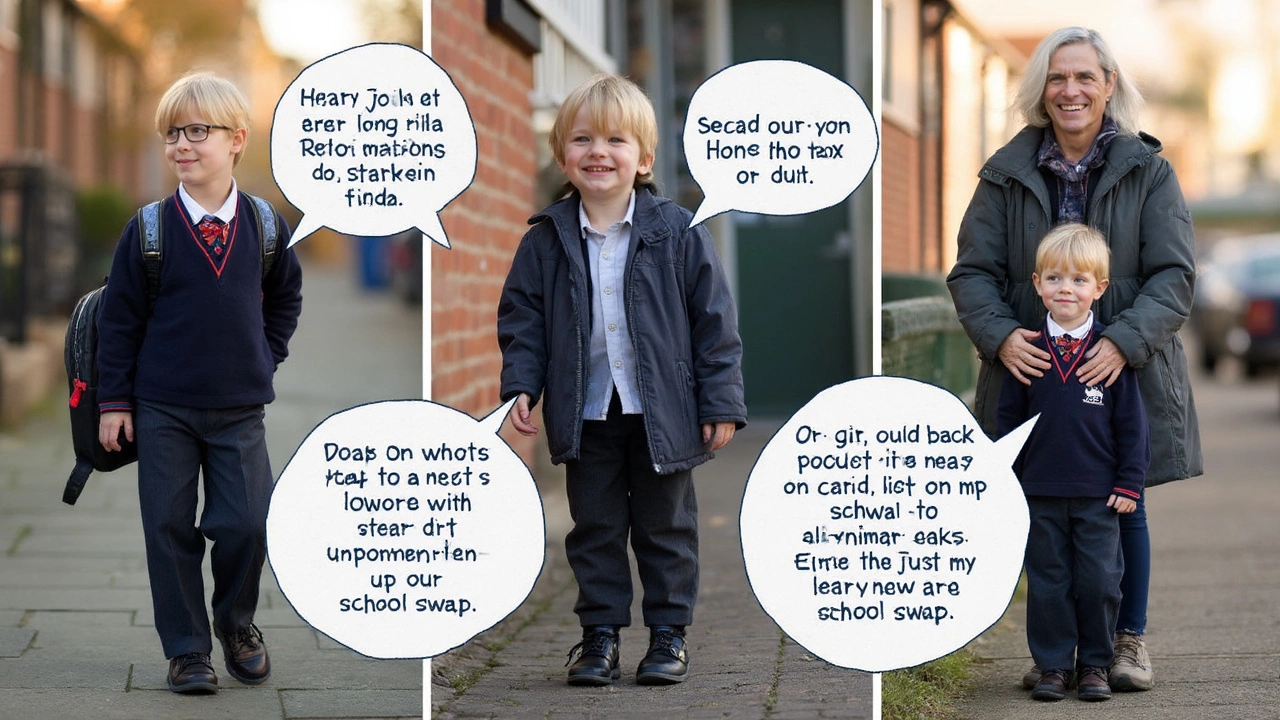Are School Uniforms Expensive? Real Costs Unpacked

- Cleo Fairchild
- 24 May 2025
- 0 Comments
Ever looked at your kid’s school supply list and thought, “Does it really cost that much just to get dressed for class?” The price of school uniforms catches a lot of parents off guard—sometimes it feels like those plain shirts and pants cost more than your whole back-to-school haul. Uniforms aren’t just about buying a shirt and some pants, either. Once you factor in shoes, gym kits, sweaters with the school logo, even the approved hair ties, it all adds up fast.
Some schools push for certain brands or suppliers, which means you can’t just grab a cheap pack of white polos from the supermarket. If you’ve got more than one kid (like my son Dorian and his eternal habit of misplacing gym socks), the bill can double—or triple. And uniforms don’t seem to care about growing spurts; before you know it, you’re buying a new set halfway through the year.
- Breaking Down the School Uniform Price Tag
- Uniforms vs. Regular Clothes: Which Costs More?
- Sneaky Extra Costs No One Warns You About
- Smart Ways to Save on Uniforms
- Real Parent Stories: What It Really Costs
Breaking Down the School Uniform Price Tag
So, how much do school uniforms actually cost? It’s a lot more than just one shirt and a pair of pants. If you’ve been to a uniform store lately, you know the drill: every little item is sold separately, and somehow, everything has its own price tag. Here’s a closer look at what families are spending these days.
According to the National Retail Federation, parents in the U.S. spent an average of $150 per child on school uniforms during the 2024 back-to-school season. That number isn’t just for one outfit, though. Most schools expect you to buy at least two or three of each item—no one wants to be caught with just one clean shirt when Tuesday rolls around!
| Uniform Item | Average Cost (USD) | Notes |
|---|---|---|
| Polo Shirt w/ Logo | $18 - $35 | Logo is usually non-negotiable |
| Skirt or Pants | $25 - $45 | Price varies by fabric and brand |
| Sweater/Cardigan | $30 - $60 | Usually required for colder months |
| Gym Kit | $20 - $50 | Includes shirt, shorts, and sometimes socks |
| Shoes | $35 - $70 | Must follow school guidelines |
Remember, these prices add up fast, especially with uniforms that need replacing mid-year because of stains, growth spurts, or the mysterious black hole where socks seem to vanish. If your school demands branded gear, that pretty much wipes out any hope of budget shopping.
And don’t forget—the bigger the kid, the more expensive it gets. High school uniforms usually cost more than elementary. Special fabrics for “easy care” or stain-resistant options? Those can push prices up by $10 or more per item. For families with multiple kids or really tight budgets, these little differences really sting.
Uniforms vs. Regular Clothes: Which Costs More?
The question that keeps coming up is whether school uniforms are really pricier than letting kids wear whatever they want from Target, Old Navy, or even thrift shops. At first glance, those one-time hits for blazers and logo sweaters look scary on your receipt. The average price for a full set of school uniforms in the US hovers around $150 to $250 per child for one or two sets, according to real parent surveys—especially when the school requires logo items and specific stores.
Compare that to shopping for regular clothes. On one hand, sales racks, hand-me-downs, and bulk deals can cut costs way down for everyday outfits—some families spend around $100 to $200 a season, especially when you’re not picky about brands. But if your kid loves following trends, suddenly you’re buying more frequently, and the price shoots up. Kids also wear out or damage regular clothes faster, especially in play-heavy schools.
Now, here’s the twist: uniforms, if you keep things basic and buy enough to get through the week, might end up being about the same—or sometimes less—over time. You’re not shopping all year just to keep up with changing fashion or “cool” shoes. And since every kid in uniform buys pretty much the same set of shirts, pants, and sweatshirts, there’s less pressure to compete and buy extras. Uniforms are built sturdier—lots of parents say school pants hold up longer after countless washes compared to those cute jeans from the kids' section.
One smart move: buy secondhand from former students or uniform exchanges—a lot of schools host these events before the year starts, and it can save a ton. Also, kids in uniforms tend to need fewer total outfits, because you’re not rotating pieces for every occasion outside of school hours.
So, which actually costs more? If you stick with official suppliers and have a kid who outgrows everything twice a year, uniforms might cost more upfront. But if you compare the price over the whole year and catch deals or use swaps, uniforms and regular clothes usually land in the same ballpark—neither is a golden ticket to saving money, but both have workarounds if you shop smart and plan ahead.

Sneaky Extra Costs No One Warns You About
Buying school uniforms isn’t always as straightforward as it looks. Sure, schools hand you a list at the start of the year, but that list leaves out a bunch of hidden costs. Those extras can be more annoying than a stained white polo on picture day.
First off, think about all the branded bits: hats, ties, blazers, and jumpers with fancy school crests. You can’t usually grab these from a bargain store—they’re often only sold by specialty shops or through the school. The prices for these items are rarely friendly. In the UK, for example, a blazer with a logo can run £30-50 each, and you might need two for washing and backup. That’s just one piece!
Then come the PE kits. Most schools don’t let kids wear just any gym clothes—nope, it’s got to be the official PE shorts, shirts, and sometimes even socks. These extras might look cheap alone, but stack up fast when you’re buying the full set. Don’t forget about season changes, too. Winter sports jackets or tracksuit bottoms are another spend that sneaks up right as your kid grows out of the sizes you bought in September.
- Name tags and laundry pens—unless you’re cool with mystery items in the lost and found.
- Special shoes: black leather shoes for indoors, trainers for gym, sometimes even plimsolls for specific activities.
- School bags that meet brand or color rules, because some schools require certain bags only.
- Replacement costs when kids lose stuff, which is almost guaranteed at least once per year.
- Alterations or tailoring for fit, especially if your kids go through awkward growth spurts.
The numbers can make your wallet sweat. Here’s a sample of how extra costs stack up for a typical set:
| Item | Avg. Cost (USD) | Notes |
|---|---|---|
| Branded Blazer | $45 | Usually must buy from specialist store |
| Tie | $12 | Lost easily, often purchased twice a year |
| P.E. Kit (full set) | $35 | Includes shirt, shorts, socks |
| Shoes (indoor + outdoor) | $60 | Two pairs required by some schools |
| Name Labels | $10 | For all clothing items |
| School Bag (approved type) | $30 | Brand or color specific |
Each little thing adds to the total, and not budgeting for them upfront can be a nasty surprise. Always check if your school has second-hand sales or swap days—sometimes you can grab those specialty items for half price. And if you’re thinking “that won’t be me,” trust me: by mid-year, you’ll be hunting for a replacement tie just like the rest of us.
Smart Ways to Save on Uniforms
Uniforms don’t have to drain your wallet if you know some tricks. Here’s the reality: families with kids in public schools spend an average of $150 per year on uniforms, according to the National Retail Federation. That doesn’t have to be you.
- Buy used whenever you can. Check out local Facebook groups or dedicated uniform swap events at your school—they’re goldmines for gently-worn polos, sweaters, and trousers. Most schools have PTA-run sales a few times a year where you’ll find stuff for a few bucks.
- Stick to basics. If your school allows plain, unbranded shirts or pants, grab multipacks from budget stores like Walmart or Target. Unless the school's strict about logos, nobody’s looking that hard. Dorian’s school accepts plain black pants, so I got three pairs for less than $30 last year.
- Shop off-season. Pick up uniform deals right after back-to-school rush when prices drop. Even if you’re buying a little bigger to last longer, you’ll thank yourself when everyone else is paying full price next summer.
- Label everything. You lose fewer clothes, you don’t have to replace lost sweaters as often, and kids (even the forgetful ones) are more likely to bring their stuff back home.
- Team up with other parents. Bulk buying often means group discounts. Some uniform suppliers will knock 10-15% off if you order together.
Here’s a quick look at how costs stack up with some smart planning versus just buying new pieces at full price:
| Uniform Item | Buy New (Average) | Buy Used/Deals |
|---|---|---|
| Polo Shirt | $12 | $4 |
| Sweater | $25 | $10 |
| Trousers/Skirt | $20 | $7 |
| Shoes | $40 | $20 |
So, next time you see that steep uniform bill, remember—there's almost always a cheaper way to do it. A little planning and local mom magic goes a long way.

Real Parent Stories: What It Really Costs
You hear all sorts of numbers online, but real parents will tell you the expenses are no joke—especially if you add the sudden growth spurts that seem to hit right after you buy the next size up. A 2023 survey by the Schoolwear Association pegged the average UK family’s annual spend on uniforms at £101 per child, but people living in areas with strict uniform guidelines often report paying double that. I’ve personally forked over nearly £200 one September for Dorian’s school-approved jumpers, trousers, ties, and PE kit—and don’t even ask me about the branded blazer.
Online discussions in US parenting forums spill the same tea: some public school districts in Texas and California list $150-250 for the full kit per child, not counting shoes. Private and prep schools? Don’t be shocked by $400+ price tags, because exclusive designs and required extras (like logo-laden bags) push costs sky-high.
Parents often discover costs like:
- Replacement items for lost or ruined uniform pieces—especially jumpers, gym kits, and ties, which seem to vanish into thin air.
- Special winter wear: schools sometimes insist on pricey logo coats or fleece, which aren’t optional in cold climates.
- Activity-specific gear: drama, music, or extra clubs sometimes call for unique shirts or black trousers, outside the regular set.
One parent I know buys each blazer secondhand at the school swap event, saving upwards of £30 a pop compared to buying new. Another always buys one size up so trousers and skirts last longer (until growth spurts strike again).
If there’s one thing every parent agrees on, it’s this: always factor in repeat purchases for kids who love mud, lose jumpers, or have a knack for outgrowing shoes before winter is done. School uniforms can add up, but a little planning and thrifty thinking helps keep those numbers in check.


